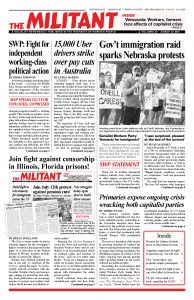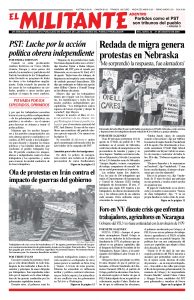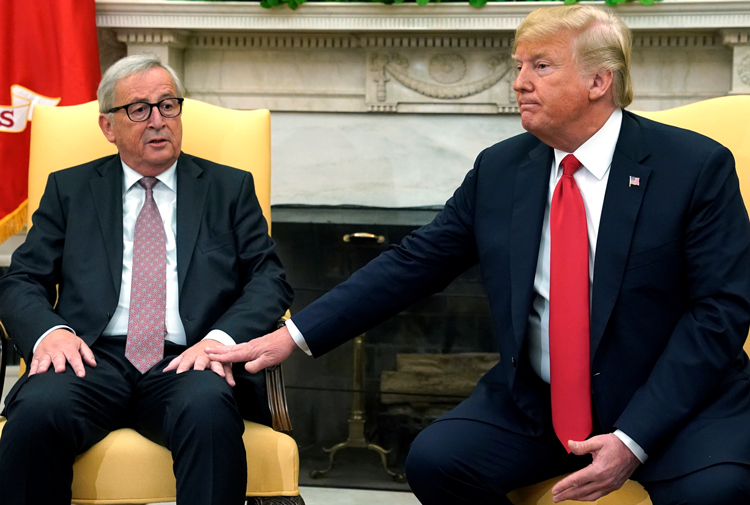President Donald Trump and Jean-Claude Juncker, president of the European Commission, met at the White House July 25 and announced they had reached a “truce” in imposing protectionist tariffs between Washington and the Berlin-led EU trading bloc. In these conflicts the president defends the interests of the U.S. propertied rulers. Juncker defends those of the same classes in Europe, above all in Germany, who effectively control and benefit most from the bloc.
The night before the meeting, Trump tweeted about the EU, “I have an idea for them. Both the U.S. and the E.U. drop all Tariffs, Barriers and Subsidies!”
Washington, however, is continuing to impose duties on steel coming from nations in Europe. The Socialist Workers Party says workers interests lie in demanding the unconditional lifting of all U.S. tariffs, regardless of where imported goods come from.
The U.S. capitalists’ trade with the EU-bloc nations is its largest worldwide by far — topping over $1.1 trillion in 2016.
The EU is a protectionist union, in which capital, commodities and labor flow more freely across borders. For a time this advanced the common interests of the national ruling classes in Europe in competition with the more powerful U.S. bosses.
The EU grew out of the European Coal and Steel Community, set up in 1951 by the rulers of France, West Germany and four other European nations. To bolster their weaker position, they pushed to expand the arrangement to include as many of the different capitalist classes in Europe as possible. The EU emerged from this expansion, swelling from six nations at its founding to 28 today, and imposing tariffs on all goods coming in beginning in 1957.
The establishment of a common currency — the euro — in 1999 among the majority of nations making up the bloc accelerated Berlin’s ability, and with it that of the other stronger northern European ruling classes, to plunder working people in the weaker southern European nations. The results have led to crises for bosses in Greece, Italy and elsewhere, and far more so for the working classes in those countries.
President Trump agreed with Juncker that Washington will hold off a threatened 25 percent tariff on German autos. Currently car bosses in the EU nations pay a 2.5 percent tariff on vehicles they sell in the U.S. In sharp contrast, capitalists in European nations use the EU to force U.S. auto bosses to pay a 10 percent tariff to sell cars in any of its 28 member nations.
U.S. power behind its trade policy
Trade talks are “just polite cover for the real use of muscle to advance the interests of conflicting national ruling classes. U.S. military might stands behind its pressure on the capitalists in Europe,” explains Jack Barnes, Socialist Workers Party national secretary, in “Imperialism’s March Toward Fascism and War,” in New International no. 10.
“Every time we hear about one of these so-called trade deals on TV, or read about them in the papers, what we’re watching unfold is the growing use of political and military clout to achieve economic ends,” Barnes wrote. “It’s the use of power to drain surplus value from wherever it’s produced by workers and toiling farmers into the pockets of the capitalists in the United States.”
Much of what is reported in the liberal media about the clashes between Washington and Berlin aims to hide this reality. It seeks to reinforce the notion that Trump’s actions are endangering Washington’s interests by threatening to tear up the decadeslong “world order” through which the U.S. rulers have collaborated with their “traditional allies” that make up the EU.
This is echoed by EU officials, who long for Washington’s continued military umbrella to defend them as they fight for markets and profits at the U.S. bosses’ expense.
But Trump and the U.S. capitalist rulers see this relation as increasingly disadvantageous, and the president demands the European rulers step up their contributions to NATO.
The German rulers believe they can effectively compete with rivals by imposing tariffs through the EU bloc, including against their U.S. “ally,” yet remain militarily dependent on them.
Washington has nearly 35,000 troops and massive air and other weaponry deployed in Germany. From 1995 Berlin began deploying its own forces in NATO operations. But in recent years its military has been allowed to become increasingly inoperative. At the end of last year none of its submarines or its largest transport planes were available due to breakdowns. As of February this year the German military had 21,000 officer posts vacant.
Trump suggested in July that the U.S. could remove a substantial number of its German-based troops and redeploy them in Poland. U.S. bases in Germany provide staging hubs for U.S. military operations in Africa and the Mideast, and the move would put them closer to Moscow.
Liberals in Europe — and their counterparts in the U.S. — often pose German Chancellor Angela Merkel as an alternative to provide leadership to hold together the old “world order.” But, the fact is, as former Secretary of State Henry Kissinger commented recently, “Among other European statesmen Angela Merkel is very local.”
Workers face a world today where a series of historic shifts are unfolding in the “order” the U.S. rulers imposed after the second imperialist world war — in Korea, the Mideast, Asia and in Europe. Trump is working within these developments to put together alliances and arrangements that favor the U.S. rulers. Many of those involve steps that can tamp down wars and conflicts that have existed for decades. These are good for working people. They open political space for us to act and learn how to fight for our class interests.
Workers have no stake in the trade and other disputes between the capitalist powers. We lose nothing if “alliances” like NATO and the EU are torn apart. NATO was used by Washington to aid its bloody wars, from Korea to Iraq and Afghanistan, wars where young workers were chewed up as cannon fodder.


